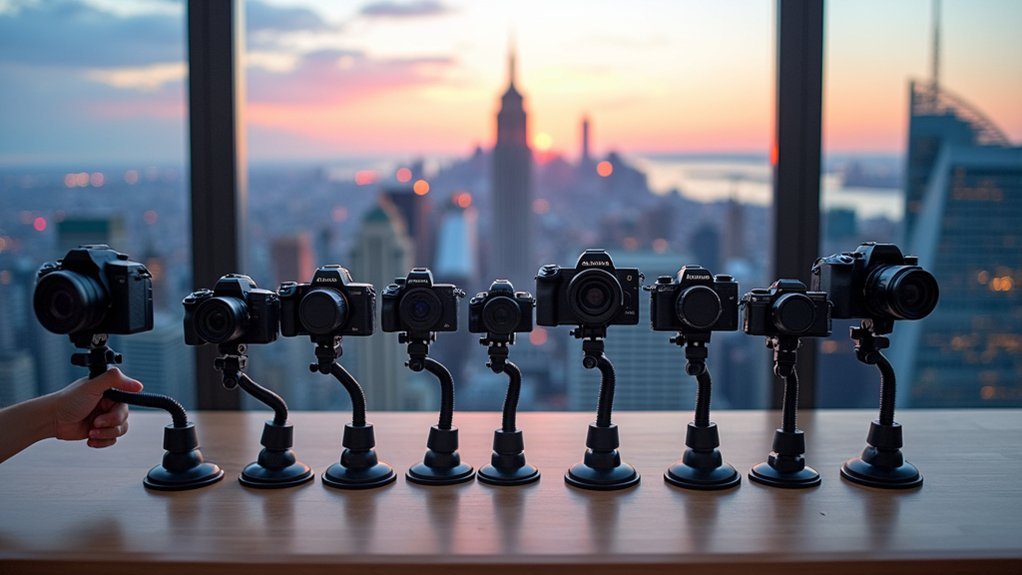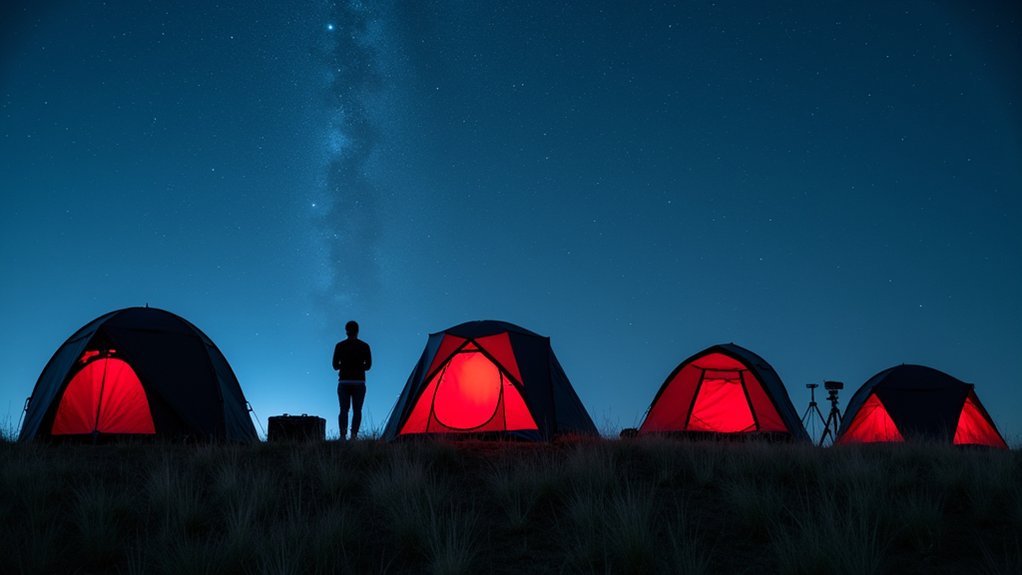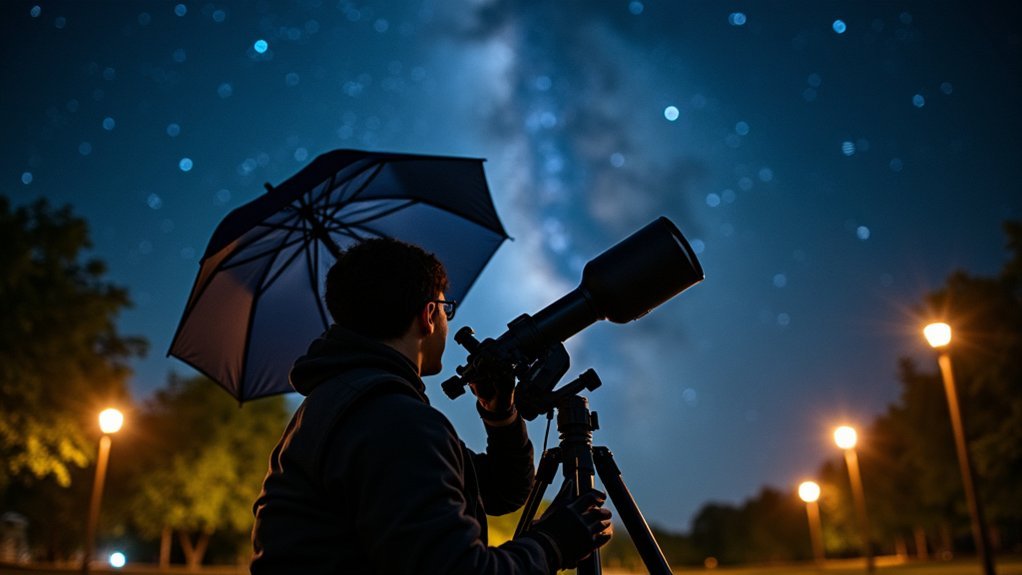To build a weather-resistant telescope power pack, start with a deep-cycle marine battery (55Ah minimum) housed in a moisture-resistant box. Add a silent power inverter, weatherproof sockets, and marine twist lock plugs for secure connections. Include circuit fusing, an automatic charger, and monitoring systems. Use heat shrink tubing and dielectric grease to protect connections. Don’t forget proper ventilation while maintaining waterproof integrity. The right combination of components guarantees reliable power during your stargazing sessions.
Essential Components for a Weather-Ready Telescope Power Pack

Reliability forms the foundation of any effective telescope power system designed to withstand the elements.
At the heart of your setup should be a deep cycle marine battery with a minimum 55Ah rating, safely housed in a sturdy battery box to protect against moisture and physical damage.
A reliable deep cycle marine battery, properly protected, powers your astronomical journey through the night.
Pair this with a high-quality, silent power inverter that converts DC battery power to 110V AC for your laptop and other astronomy equipment.
Choose one that won’t generate noise that could disrupt your stargazing sessions.
Complete your power pack with weatherproof sockets and marine twist lock plugs that maintain secure connections even in challenging conditions.
Don’t forget to incorporate individual circuit fusing and an automatic charger system that can remain connected, ensuring your battery stays ready for your next observation night.
Selecting the Right Battery Type for Astronomical Equipment
When building your weather-resistant telescope power pack, you’ll need to choose a deep-cycle leisure battery rather than a standard car battery to prevent damaging over-discharge during long imaging sessions.
Your battery’s Amp-hour (Ah) rating determines how long your equipment will run, with experts recommending at least double your estimated power needs to maintain battery health above the critical 50% threshold.
Maintenance-free deep-cycle batteries offer the best combination of reliability and convenience for astronomical field work, eliminating the hassle of water topping while providing consistent power throughout your observation sessions.
Battery Capacity Considerations
Selecting the right battery type proves essential for powering astronomical equipment during extended night sessions. When building your battery pack, choose a deep-cycle leisure battery rather than a standard car battery to prevent over-discharge and maintain longevity.
Battery capacity is measured in amp hours (Ah), with higher ratings providing longer usage times. For instance, a 55Ah battery can theoretically support imaging for about 14 hours at idle.
However, you’ll want to drain your deep-cycle leisure battery only to about 20% capacity and never below 50% for best lifespan.
When calculating your requirements, double the total amp-hour rating needed to account for your actual power draw and session length.
Consider the trade-offs between capacity, weight, and cost when choosing between 75-85Ah batteries based on your specific needs and portability requirements.
Deep Cycle vs. Regular
The difference between deep cycle and regular batteries greatly impacts your astronomy experience, particularly during extended observing sessions. Deep cycle batteries are specifically designed to withstand repeated discharge-recharge cycles, making them ideal for powering telescopes and accessories throughout the night.
| Feature | Deep Cycle | Regular |
|---|---|---|
| Discharge | Safely to 50% | Shallow only |
| Usage | Long duration | Short bursts |
| Lifespan | Longer with proper care | Shorter in astronomy use |
When selecting a battery, choose a maintenance-free deep cycle battery that won’t require water topping and can withstand outdoor conditions. These batteries handle consistent power draw more efficiently and won’t degrade as quickly when powering multiple devices. Remember to calculate your total equipment power needs and select a battery with at least double that capacity for peak performance.
Waterproof Housing Options and Considerations

A reliable power pack for your telescope requires appropriate waterproof housing to withstand unpredictable weather conditions.
When selecting waterproof housing, prioritize durable materials like ABS plastic or marine-grade aluminum that resist both moisture and impact damage during nighttime observations.
Your housing should feature a weatherproof seal with rubber gaskets or O-rings to prevent water ingress. Look for products with IP67 or higher ratings, ensuring protection during unexpected rain or high humidity situations.
Don’t overlook ventilation – proper airflow prevents component overheating while maintaining waterproof integrity. This balance is essential for electronic longevity during extended stargazing sessions.
Finally, invest in corrosion-resistant hardware like stainless steel screws and marine-grade connectors. These materials greatly extend your power pack’s lifespan in the damp environments often encountered during nighttime astronomy.
Proper Wiring and Connection Methods for Moisture Resistance
While protecting your telescope’s power pack from the elements, proper wiring and connection methods serve as your first line of defense against moisture damage.
Install marine twist lock plugs for superior connections that maintain weatherproofing even when disconnected.
Secure wiring connections using heat shrink tubing to create effective moisture barriers and prevent long-term corrosion.
Position circuit breakers close to battery terminals for electrical protection without compromising weather resistance.
Don’t overlook weatherproof sockets and enclosures – these components shield sensitive electrical parts from humidity and precipitation during nighttime observing sessions.
For enhanced moisture resistance, apply dielectric grease to any exposed connections, which prevents oxidation and rust formation.
This simple step greatly extends the lifespan of your connections in humid or dewy conditions.
Installing Multiple Voltage Outputs for Various Accessories

When building your weather-resistant power pack, you’ll need different voltage outputs to power everything from 12V mounts to 5V cameras and USB-charged devices.
Install marine-grade connectors for each voltage requirement, using buck converters to efficiently step down from your battery’s voltage to what your accessories need.
Don’t forget to protect each circuit with appropriately rated fuses—10 Amp for standard outputs and 5 Amp for USB connections—to prevent damage from power surges or short circuits in damp conditions.
Voltage Output Options
Multiple voltage outputs form the backbone of a versatile telescope power pack, letting you simultaneously power various accessories during astrophotography sessions. Using buck converters, you’ll efficiently step down voltage from your portable power supply to accommodate various devices. Include both 12V cigarette lighter sockets and USB ports to maximize compatibility with your astronomy equipment.
| Output Type | Typical Devices | Recommended Fuse |
|---|---|---|
| 12V Cigarette Lighter | Telescope Mount, Cooled Cameras | 5-10A |
| USB-A (5V) | Smartphones, Controllers | 2-3A |
| Variable Output (9-12V) | Dew Heaters, Laptops | 3-5A |
| USB-C Power Delivery | Modern Cameras, Tablets | 3A |
Always individually fuse each outlet to protect against overcurrent situations. Regularly inspect connections to prevent power drop-outs, ensuring reliable operation throughout your entire imaging session.
Circuit Protection Considerations
Safeguarding your telescope’s electrical system requires robust circuit protection when installing multiple voltage outputs. Your power pack’s reliability depends on proper safeguards to prevent shorts and protect each accessory.
To guarantee ideal power distribution and safety:
- Install circuit breakers close to the battery terminal to immediately prevent shorts and over-current conditions.
- Use a dedicated fuse box for individual circuits so one accessory failure won’t compromise your entire setup.
- Integrate voltage/amperage meters to monitor current draw from each accessory, helping you detect potential issues early.
- Employ marine twist lock plugs for all connections to enhance weatherproofing and maintain secure power delivery in damp conditions.
This layered protection approach guarantees your telescope’s components receive clean, consistent power while protecting your investment from electrical damage during field use.
Adding Power Monitoring Systems and Low Voltage Protection
To maximize your telescope battery’s lifespan and performance, you’ll need reliable monitoring and protection systems. Install an LCD read-out that displays voltage, current, and power consumption in real-time. This power monitoring system helps you track your setup’s approximately 3A idle draw, ensuring you’re operating within ideal limits.
Incorporate low voltage protection circuits that automatically shut off power when voltage drops below the safe threshold. This prevents damaging deep discharges that greatly shorten battery life.
For thorough protection, add a fuse box with Anderson PowerPole connectors to guard against overcurrent situations.
Voltage and amperage meters provide continuous insights into battery health, allowing you to recharge at the right time. These monitoring tools are essential for maintaining power efficiency throughout extended astrophotography sessions in remote locations.
Thermal Management in Extreme Weather Conditions

Because battery performance drastically changes with temperature fluctuations, effective thermal management becomes essential for any astronomical power setup. Your batteries operate best between 32°F-104°F (0°C-40°C), with capacity potentially dropping by half in extreme cold.
Temperature extremes can cut your battery capacity in half—proper thermal management isn’t optional for serious astronomy.
To optimize your power pack’s thermal management:
- Insulate your battery enclosure using foam or specialized battery blankets when observing in sub-freezing conditions.
- Install PWM controllers for your dew heaters that efficiently regulate temperature while preventing condensation on optics.
- Ensure proper ventilation in your power pack design, particularly around inverters that generate heat during operation.
- Monitor battery temperature regularly with a simple thermometer or integrated sensor to prevent thermal-related failures.
These measures will maintain battery efficiency and extend your imaging sessions regardless of weather conditions.
Field Testing Your Telescope Power Pack
After implementing proper thermal management for your power system, you’ll need to validate its performance in actual observing conditions.
Begin by conducting initial circuit tests on your power pack before heading to your observation site, ensuring all components function correctly.
During field testing, monitor your setup’s power draw—typically about 3A at idle—using voltage and amperage meters to track battery status throughout the night.
This data helps you manage battery capacity effectively during extended observing sessions.
Keep your battery’s discharge above 20% to protect your deep cycle battery and maintain peak performance.
The real-world conditions will reveal how well your power pack handles the demands of your telescope system.
Share your experiences with fellow astronomers to gather feedback and refine your setup for future stargazing adventures.
Portable Design Features for Easy Transport

You’ll find your telescope power pack much easier to transport with a collapsible handle system that extends when needed and tucks away during operation.
Weather-sealed component compartments protect your battery, inverter, and connections from unexpected rain or morning dew while moving between observation sites.
These protective compartments also serve as natural dividers that keep your components organized and prevent them from shifting against each other during transport.
Collapsible Handle System
Mobility meets durability in our power pack’s innovative collapsible handle system. You’ll appreciate how this thoughtfully designed feature transforms your astrophotography experience, making transport between observation sites effortless while maintaining the integrity of your power supply.
The handle system incorporates:
- Lightweight materials that add minimal weight to your overall setup
- A robust locking mechanism that prevents unexpected collapse during transport
- Secure attachment points that maintain internal component stability even when moving across rough terrain
- A space-saving fold-away design that minimizes bulk when stored
When you’re focusing on capturing the perfect celestial image, the last thing you need is equipment transport challenges. Our collapsible handle guarantees your power pack remains a helpful companion rather than a cumbersome burden during your nighttime adventures.
Weather-sealed Component Compartments
Protection stands as the cornerstone of our power pack’s weather-sealed compartment design. Your valuable electronics remain safe inside individual weather-resistant chambers, each with specialized flaps and seals that prevent moisture and dust infiltration when you’re stargazing under challenging conditions.
The internal layout strategically positions your battery and inverter in secure mounting points, preventing shifting during transport to remote viewing sites. We’ve incorporated marine-grade connectors throughout the system to guarantee reliable power delivery even in damp conditions, eliminating frustrating power interruptions during critical observations.
Each compartment within the sturdy plastic toolbox base features reinforced edges and gasket seals, creating a lightweight yet durable housing system you can confidently take anywhere.
This thoughtful weather-sealed component compartment design means your astronomy power supply remains protected regardless of field conditions.
Budget-Friendly Materials and Alternative Solutions
While commercial telescope power packs can easily cost hundreds of dollars, building your own weather-resistant version offers significant savings without sacrificing functionality. A budget-friendly approach uses readily available components that provide reliable power for your astronomical equipment.
Slash your telescope power expenses while maintaining quality with a simple DIY solution using everyday components.
- Plastic toolbox ($15-25) – Serves as your housing, offering easy modification for component mounting and natural weather resistance.
- Sealed deep-cycle marine battery ($50-100) – Provides ample power capacity at a fraction of commercial power pack prices.
- Weatherproof marine twist lock plugs ($10-15) – Guarantees reliable connections even in damp conditions, preventing frustrating power drops.
- Basic hardware store components ($20-30) – Simple 12V cigarette lighter sockets and rocker switches keep costs down while maintaining functionality.
Include an automatic charger to maintain battery health between observation sessions.
Frequently Asked Questions
How Often Should I Recharge the Power Pack After Use?
You should recharge your power pack after each use to maintain peak performance. Don’t wait until it’s completely drained. Regular recharging extends battery life and guarantees it’s ready for your next observation session.
Can I Use the Power Pack With Non-Astronomy Equipment?
Yes, you can use your power pack with non-astronomy equipment. It’ll work with any devices that match its voltage output and don’t exceed its capacity. Just check compatibility before connecting to prevent damage.
How Long Will a Typical Power Pack Last Before Needing Replacement?
With proper care, your power pack can last 3-5 years before needing replacement. Battery cells typically degrade after 300-500 charge cycles, but you’ll extend lifespan by avoiding complete discharges and extreme temperatures.
Is It Safe to Use During Light Rain or Fog?
Yes, you’ll be safe using it during light rain or fog. It’s designed to be weather-resistant, but you shouldn’t submerge it. Cover it with additional protection during heavier downpours for maximum safety.
Can I Connect Multiple Telescopes to a Single Power Pack?
Yes, you can connect multiple telescopes to a single power pack as long as you don’t exceed its total power output capacity. Just make sure you’re using appropriate splitters and each telescope’s voltage requirements match.
In Summary
Building your own weather-resistant telescope power pack isn’t just economical—it’s empowering. You’ve learned how to protect your investment from moisture, temperature extremes, and field conditions while ensuring reliable power for all your astronomical gear. With proper waterproofing, thermal management, and portable design, you’ll spend less time worrying about equipment failures and more time enjoying the cosmos, regardless of what Mother Nature throws your way.





Leave a Reply